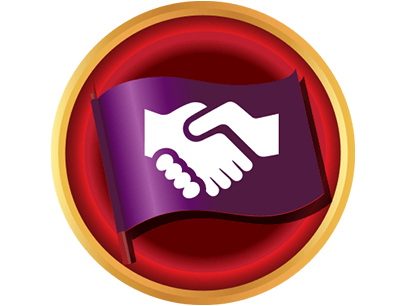
You can be a leader. In fact, you already are. You may not serve in an official leadership role, but nearly everyone has been in the driver’s seat for something. Maybe it was a group project in school. Or leading a project at work. Maybe you organized a family event or an open house for your club.
Whatever the situation, you likely had to juggle many different skills at once: time management, communication, motivation (for yourself and for others), and planning, from the big picture down to bite-size details. If you want to improve all those skills and be more in tune with your inner leader, try your hand at the Leadership Development path in the Pathways learning experience.
Like the other paths in the program, Leadership Development begins by helping you learn fundamental competencies at Level 1, such as speechwriting, evaluation and research. After that, participants tackle projects that build on each other and allow you to tailor your learning to your personal goals.
Your Inner Leader
Time management may seem trivial when you consider the dynamic qualities leaders possess. But planning your time, even on the smallest, minute-to-minute scale, sets you up for bigger successes.
When you dig into Level 2 and the “Managing Time” project, you learn various techniques to improve time management and productivity, such as tracking time and prioritizing tasks. Nikhila Chenreddy, of Citi Singapore Toastmasters in Central Singapore, says this project helped her as a new member. At first, when giving speeches, she would rush her last points to finish on time. This project helped her develop a speech-timing structure she still uses as she develops new speeches. Chenreddy’s increased awareness of time management has also paid off in her professional life; she is a solutions architect of consumer technology at Citibank, a financial services company.
“We found that the number one precursor to people sticking around [in Toastmasters] is having a mentor.”
— JOHN RODKE, DTM“Recently I conducted a weeklong workshop with one vendor to onboard a product,” says Chenreddy. “One of the key factors was ensuring that the vendor’s daily deliverables were presented on time and all the questions from our employees were addressed by the vendor during the workshop.”
In the “Understanding Your Leadership Style” project, also in Level 2, participants identify the qualities of a good leader and how a leader’s behavior affects those they lead. These insights come into play later in the path.
Planning and Organizing
When members reach Level 3, they work on the “Planning and Implementing” project, in which they practice time- management skills to organize and carry out an event or project. They also lead a team if they need one.
Participants learn about project planning and all the processes involved, such as creating a plan, defining tasks and identifying potential risks before they occur. The project is full of helpful resources, including event and project- planning worksheets. It also details the benefit of using a Gantt chart—a graphical timeline of a project’s tasks and milestones.
John Rodke, DTM, from Eugene, Oregon, fulfilled this project by developing a plan when he was a program quality director in 2017-2018 for outgoing area directors to help incoming area directors. It called for the experienced area directors in his district to provide tips and strategies to the new ones before they started their role. The project involved coordinating many logistics, as well as checking in regularly to evaluate progress. The outcome? “About 25 percent of our area directors participated. Those who did had their successors ready to go,” says Rodke, a 2018-2019 district director.
Boosting Your Team
At Level 4, you get to really flex your leadership skills. In the “Leading Your Team” project, you learn attributes of good leaders, such as communicating effectively, possessing integrity, being optimistic and being open-minded. Why that last quality? Because as the project shows, it’s important for a leader to listen and show willingness to consider new ideas. Doing so shows team members that you value them and ultimately empowers them to work harder.
The project also outlines techniques for motivating others and effective coaching. For example, it demonstrates how a successful coach should achieve goals, explain why certain activities are undertaken, acknowledge and listen to team members, seek a variety of opinions to reach solutions, follow up to ensure accountability, and praise positive results.
To learn these skills, participants initiate their own project and lead a team to complete it. Both Chenreddy and Rodke used this assignment to develop mentoring programs within their districts and clubs.
“We found that the number one precursor to people sticking around [in Toastmasters] is having a mentor,” says Rodke. He led the district’s program quality director and a group of vice presidents education to establish a new method for creating more mentorships within clubs.
To ensure the success of this new approach, Rodke developed a communication plan that involved presentations, trainings, online publications and in-person conversations. “Just having somebody to talk to helped members succeed,” he says.
All the projects in the path include resources to help you set goals, develop communication plans and manage details.
Leading on a Large Scale
Level 5 is where all your emerging skills coalesce. In the “Manage Successful Events” project, you oversee an event of your design and lead a team in the process. You learn even more leadership strategies, such as how best to delegate responsibilities to team members. Doing so makes you a stronger leader.
Chenreddy leveraged everything she learned along the way to plan a large annual party at her company, which included games, a talent show and a bonanza of fruit.
In anticipation of 300 attendees, she formed a team and began planning months in advance. The leadership skills she learned in the path, such as communication, coaching and motivating others, helped her manage a last-minute conflict regarding a fruit-decorating activity, she says.
“All the projects in the path include resources to help you set goals, develop communication plans and manage details.”
“One of my team members wanted to give everyone knives to decorate the fruit. I wasn’t very keen on that because if one person got injured, the event would be a failure. I tasked her with thinking of something else so we could still have the game but without knives.”
Her colleague arrived at a solution. The decorating activity, and the entire event, was a success.
As you consider embarking on the Leadership Development path, Chenreddy stresses, be open-minded about yourself and your abilities. “Jump in and enjoy the ride of exploring the leader in you, because you already were one when you chose to make a change by joining Toastmasters.”
For more information about the Leadership Development path, go to the Pathways page on the Toastmasters website.
Shaelyn Berg worked on the Pathways development team at Toastmasters World Headquarters and is now a freelance writer and editor.



 Previous
Previous
 Previous Article
Previous Article

